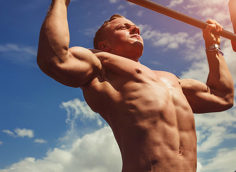Foundation Before Specificity
I once saw a coach training a hockey player on lunges.
He said, "When you stand up, push a bit sideways with your front leg to mimic your skating stroke."
Doesn't seem like bad advice... except that the athlete was 12 years old.
The kid wasn't even able to stay stable when going down into the lunge. His front knee was caving in and his torso was bent so far forward it looked like he was doing a good morning.
Sure, if he pushes slightly sideways it might mimic his skating stroke. Sort of. Maybe.
But this is like worrying about the color of the curtains when the house is built on a lousy foundation and the walls aren't even finished. It's an example of one thing that's gone horribly wrong with strength coaching.
Strength coaches worry about minutia, trying to make a movement as specific as possible, while the athlete doesn't even have the strength foundation and motor control to do the basics properly.

A certain degree of specificity can be important, relative to the athlete's sport. You need to develop the correct energy systems and increase the capacity to produce maximum force and power in the movement patterns involved in the sport.
But if you increase strength and power in those very specific patterns without developing general strength and power, you're doomed to fail.
Making technical modifications, or even creating new exercises so that you can work on the movements involved in your sport, sounds good.
It will, after all, win the confidence of the sport coach. It'll make the athlete think you're in touch with his sport and it'll make you look cutting edge. But it'll do your athletes a great disservice.
Russian coaches had it right: first build the widest base possible.
That means increasing the general physical capacities (strength, power, endurance, resistance, speed) as high as you can, then worrying about including more specific work.
An athlete who's stronger, more powerful, and faster, but only does general work, will destroy a weaker and less powerful athlete who does tons of specific work.
Strength training can never really be specific. The only true specific action is practicing the action itself.
And if you try to make the strength training movements too similar to the sporting action you can actually screw up the motor pattern.
When two actions are extremely similar but just different enough (due to the resistance) to make the original pattern suboptimal, you will create a "confusion" which will decrease neural efficiency and decrease your skills.
Arthur Jones once gave the example of a high school quarterback who trained on a pulley apparatus that allowed him to do his throwing motion against resistance, thinking that he would throw much farther when the season came.
What happened? It screwed up his throwing motion and he couldn't hit a pink elephant in a white corridor.
One of my friends, a great sprinter, once spent 6 months training with a sprint coach who added slightly-weighted insoles in his shoes, reasoning that his hip flexors would get stronger and his stride frequency would increase, making him run faster.
Well, his 60 meter time got slower. When we did a video analysis, his stride was completely out of whack.
Being too specific is dumb. And being specific too early is dumb.
This is especially true with younger athletes. All you really need is to get them very strong on the big basic lifts. That alone will give them a maximal rate of progress in field performance.
Just by becoming a lot stronger their power will improve. And when power improves, speed increases too.
At some point, getting stronger won't have such a huge impact.
For example, if an athlete goes from a 185 pound bench and 225 pound squat to a 315 bench and 405 squat he'll have a huge increase in performance. But past that, strength alone won't make much of a difference.
At that point what you need to do is increase the rate of force development, i.e. producing force more rapidly using explosive drills, like variations of the Olympic lifts, weighted jumps and throws, etc. This will again restart a rapid progression in athletic potential.
Once that fails to create progress, "specific work" will become useful. This is called accentuation.

It's not about trying to mimic the sporting movements in the gym. Rather, it's doing strength or power work in the specific ranges of motion involved in the sport.
Here's an example:
Let's say that when you run, you have to produce maximum force with the knee bent at 110 degrees. Use supramaximum partial squats or jump squats with 20-30% of the squat max from that angle.
It's specific enough to give results because you're overloading the important part of the range of motion, but not so specific that it messes with motor pattern. Chains and bands can be used for the same purpose.
That's as specific as I'll go in the gym. Strength training is there to get you stronger and more powerful overall. It's there to correct muscle imbalances. And it's there to reduce the risk of injuries.
If you want to get more specific than that, go to the field and do sport-specific drills.
Don't try to turn a hammer (strength training) into a universal tool. It's the best tool to get strong and powerful.
Use it for that purpose and stop trying to be cute.




